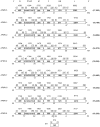Complete genome sequence of avian paramyxovirus (APMV) serotype 5 completes the analysis of nine APMV serotypes and reveals the longest APMV genome
- PMID: 20174645
- PMCID: PMC2822847
- DOI: 10.1371/journal.pone.0009269
Complete genome sequence of avian paramyxovirus (APMV) serotype 5 completes the analysis of nine APMV serotypes and reveals the longest APMV genome
Abstract
Background: Avian paramyxoviruses (APMV) consist of nine known serotypes. The genomes of representatives of all APMV serotypes except APMV type 5 have recently been fully sequenced. Here, we report the complete genome sequence of the APMV-5 prototype strain budgerigar/Kunitachi/74.
Methodology/principal findings: APMV-5 Kunitachi virus is unusual in that it lacks a virion hemagglutinin and does not grow in the allantoic cavity of embryonated chicken eggs. However, the virus grew in the amniotic cavity of embryonated chicken eggs and in twelve different established cell lines and two primary cell cultures. The genome is 17,262 nucleotides (nt) long, which is the longest among members of genus Avulavirus, and encodes six non-overlapping genes in the order of 3'N-P/V/W-M-F-HN-L-5' with intergenic regions of 4-57 nt. The genome length follows the 'rule of six' and contains a 55-nt leader sequence at the 3'end and a 552 nt trailer sequence at the 5' end. The phosphoprotein (P) gene contains a conserved RNA editing site and is predicted to encode P, V, and W proteins. The cleavage site of the F protein (G-K-R-K-K-R downward arrowF) conforms to the cleavage site motif of the ubiquitous cellular protease furin. Consistent with this, exogenous protease was not required for virus replication in vitro. However, the intracerebral pathogenicity index of APMV-5 strain Kunitachi in one-day-old chicks was found to be zero, indicating that the virus is avirulent for chickens despite the presence of a polybasic F cleavage site.
Conclusions/significance: Phylogenetic analysis of the sequences of the APVM-5 genome and proteins versus those of the other APMV serotypes showed that APMV-5 is more closely related to APMV-6 than to the other APMVs. Furthermore, these comparisons provided evidence of extensive genome-wide divergence that supports the classification of the APMVs into nine separate serotypes. The structure of the F cleavage site does not appear to be a reliable indicator of virulence among APMV serotypes 2-9. The availability of sequence information for all known APMV serotypes will facilitate studies in epidemiology and vaccinology.
Conflict of interest statement
Figures




Similar articles
-
Molecular characterization and complete genome sequence of avian paramyxovirus type 4 prototype strain duck/Hong Kong/D3/75.Virol J. 2008 Oct 20;5:124. doi: 10.1186/1743-422X-5-124. Virol J. 2008. PMID: 18937854 Free PMC article.
-
Complete sequence of the genome of avian paramyxovirus type 9 and comparison with other paramyxoviruses.Virus Res. 2009 Jun;142(1-2):10-8. doi: 10.1016/j.virusres.2008.12.016. Epub 2009 Jan 29. Virus Res. 2009. PMID: 19185593 Free PMC article.
-
Complete genome sequences of avian paramyxovirus serotype 6 prototype strain Hong Kong and a recent novel strain from Italy: evidence for the existence of subgroups within the serotype.Virus Res. 2010 Jun;150(1-2):61-72. doi: 10.1016/j.virusres.2010.02.015. Epub 2010 Mar 4. Virus Res. 2010. PMID: 20206652 Free PMC article.
-
Avian Paramyxovirus: A Brief Review.Transbound Emerg Dis. 2017 Feb;64(1):53-67. doi: 10.1111/tbed.12355. Epub 2015 Apr 28. Transbound Emerg Dis. 2017. PMID: 25924108 Review.
-
Evolutionary history of cotranscriptional editing in the paramyxoviral phosphoprotein gene.Virus Evol. 2021 Mar 27;7(1):veab028. doi: 10.1093/ve/veab028. eCollection 2021 Jan. Virus Evol. 2021. PMID: 34141448 Free PMC article. Review.
Cited by
-
Feline Morbillivirus Infection in Domestic Cats: What Have We Learned So Far?Viruses. 2021 Apr 15;13(4):683. doi: 10.3390/v13040683. Viruses. 2021. PMID: 33921104 Free PMC article. Review.
-
Characterization of novel avian paramyxovirus strain APMV/Shimane67 isolated from migratory wild geese in Japan.J Vet Med Sci. 2015 Sep;77(9):1079-85. doi: 10.1292/jvms.14-0529. Epub 2015 Apr 11. J Vet Med Sci. 2015. PMID: 25866408 Free PMC article.
-
Evidence for a new avian paramyxovirus serotype 10 detected in rockhopper penguins from the Falkland Islands.J Virol. 2010 Nov;84(21):11496-504. doi: 10.1128/JVI.00822-10. Epub 2010 Aug 11. J Virol. 2010. PMID: 20702635 Free PMC article.
-
Mutations in the fusion protein cleavage site of avian paramyxovirus serotype 2 increase cleavability and syncytium formation but do not increase viral virulence in chickens.J Virol. 2011 Jun;85(11):5394-405. doi: 10.1128/JVI.02696-10. Epub 2011 Mar 30. J Virol. 2011. PMID: 21450835 Free PMC article.
-
Metatranscriptomic Analysis of Virus Diversity in Urban Wild Birds with Paretic Disease.J Virol. 2020 Aug 31;94(18):e00606-20. doi: 10.1128/JVI.00606-20. Print 2020 Aug 31. J Virol. 2020. PMID: 32581107 Free PMC article.
References
-
- Lamb R, Parks G. Paramyxoviridae: the viruses and their replication. In: Knipe DM, Howley PM, Griffin DE, Lamb RA, Martin MA, Roizman B, Straus SE, editors. Philadelphia: Lippincott Williams & Wilkins; 2007. pp. 1449–1496.
-
- Lamb RA, Collins PL, Kolakofsky D, Melero JA, Nagai Y, et al. Family Paramyxoviridae. In: Fauquet CM, editor. Virus Taxonomy: The Classification and Nomenclature of Viruses; 2005. The Eighth Report of the International Committee in Taxonomy of Viruses. Press EA, editor.
Publication types
MeSH terms
Substances
Associated data
- Actions
Grants and funding
LinkOut - more resources
Full Text Sources
Other Literature Sources
Research Materials

